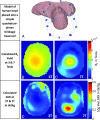Ultra-High-Field MR Neuroimaging
- PMID: 25523591
- PMCID: PMC4472608
- DOI: 10.3174/ajnr.A4180
Ultra-High-Field MR Neuroimaging
Abstract
At ultra-high magnetic fields, such as 7T, MR imaging can noninvasively visualize the brain in unprecedented detail and through enhanced contrast mechanisms. The increased SNR and enhanced contrast available at 7T enable higher resolution anatomic and vascular imaging. Greater spectral separation improves detection and characterization of metabolites in spectroscopic imaging. Enhanced blood oxygen level-dependent contrast affords higher resolution functional MR imaging. Ultra-high-field MR imaging also facilitates imaging of nonproton nuclei such as sodium and phosphorus. These improved imaging methods may be applied to detect subtle anatomic, functional, and metabolic abnormalities associated with a wide range of neurologic disorders, including epilepsy, brain tumors, multiple sclerosis, Alzheimer disease, and psychiatric conditions. At 7T, however, physical and hardware limitations cause conventional MR imaging pulse sequences to generate artifacts, requiring specialized pulse sequences and new hardware solutions to maximize the high-field gain in signal and contrast. Practical considerations for ultra-high-field MR imaging include cost, siting, and patient experience.
© 2015 by American Journal of Neuroradiology.
Figures












References
-
- Clow H, Young IR. Britain's brains produce first NMR scans. New Scientist 1978;80:588
-
- Atlas SW. Magnetic Resonance Imaging of the Brain and Spine. Vol. 1. Philadelphia: Lippincott Williams & Wilkins; 2009
-
- Kraff O, Fischer A, Nagel AM, et al. . MRI at 7 Tesla and above: demonstrated and potential capabilities. J Magn Reson Imaging 2015;41:13–33 - PubMed
-
- Uğurbil K, Adriany G, Andersen P, et al. . Ultrahigh field magnetic resonance imaging and spectroscopy. Magn Reson Imaging 2003;21:1263–81 - PubMed
Publication types
MeSH terms
Grants and funding
LinkOut - more resources
Full Text Sources
Other Literature Sources
Medical
